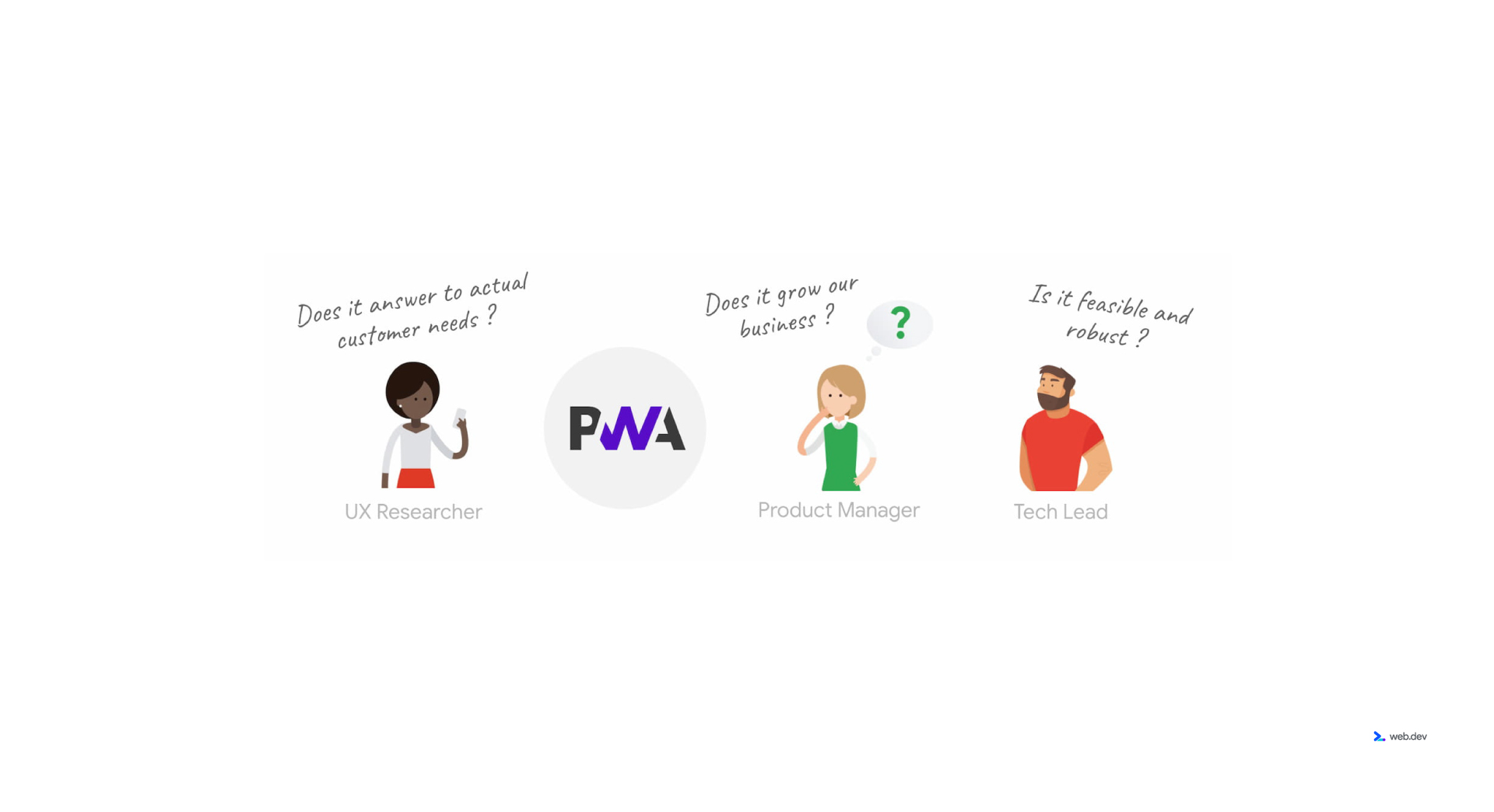
Progressive web apps are created using the applications our generation adores, namely, HTML, CSS and JavaScript, but with a functionality combating that of a native app. They are, in lucid words, web apps with a native app flavour. When you visit a site on your smartphone, you can fix it onto your home screen. Simply, logging in will be similar to what you used to on your native app, with the matter of concern being that there will be no browser window; and you’re good to go now. That is,unarguably, a massive aid in building an app with PWA in the hindsight of your mind. PWAs are sooner grasping acclaim. Most of the renowned sites like Starbucks, Pinterest, Twitter, Uber etc., can be fixed on your home screen and somewhat, their experience tantamount to their native apps.
What are the technical components of a PWA?
Four technical components uphold the PWA traits.
- The Web App manifest is a JSON file that bestows the native app appearance onto the progressive web app. This file oversees in which way is the app displayed to the user in full screen mode without a URL bar visible to the user and how it is launched.
- Service Worker handles major functions like the offline work mode, background syncs, push notifications typical for native apps. It is a JavaScript file running separately from the web app, and because it runs to process a particular event, its lifetime is brief.
- The application shell architecture entails segregation of static and dynamic content. It comprises the core design elements needed to run the application without the connection. It performs in an apt way for the JavaScript-laden apps enclosing one page, with comparatively stable navigation and altering content.
- Transport Layer Security is a standard of secure and robust data exchange between two applications, by leveraging the Transport Layer Security (TLS) Protocol.
Which are the well-known Progressive Web App frameworks?
It is a necessity to pick one of the apt PWA frameworks, in order to better the performance and add on to its business perks. Below are few of the favoured frameworks :
- Angular PWA : It is the most well liked front-end web app development. It also facilitates creation of PWAs that are responsive in nature and offer a two-way data binding feature.
- React PWA : It is a JavaScript based library leading to creation of user interfaces, via one way data flow, which facilitates enhanced inspection of changes in the application.
- Vue PWA : It is, too, a JavaScript based library that combines elements of both Angular(template style) and React(component based props) frameworks. Because of its lucid architecture, it is easy to understand and integrate.
- Iconic PWA : It is an open source framework, with manageable code, thus, reducing time and efforts of developers. Being a cross-platform application development framework, it uses one code base, where applications get used to various platforms like-wise.
What is the difference between a native app and a PWA?
A native app, similar to the ones downloaded from Google’s Play Store or Apple’s App Store, is usually built on a programming language specific to that platform. Hence, building an app requires thorough knowledge of the technology aiding its creation. So, to run an app on all the mobile platforms, you need to be familiar with all different technologies.
There is an approach, which extracts the goodness of both worlds, via a progressive web app. It runs on a browser, and on saving it onto the home screen, it resembles a native app in all ways. It also gets access to the concealed hardware and software that the browser can’t peek into due to safety reasons. Still, a native app can go deeper. Also, PWAs are not the ultimate alternatives for building high-performance games.
What are the advantages of a PWA over a native app?
Overviewing the perks of PWA, which encapsulated the following :
- Building a PWA is easier, as it engages common web technologies.
- Considerably cheaper in terms of construction.
- Often very responsive and have an ability to work with different screen sizes.
- Installing a PWA points to higher engagement.
- They work both offline and on low-quality networks, contrary to your regular sites.
- Usage of push notifications, ensuring re-engagement of users.
- Self-updation keeps the app fresh.
- They can very well mimic navigation and interactions of native apps.
What are the few of the successfully developed examples of PWA?
- PINTEREST was determined to cling onto PWA when they realised they offered a slower website experience. PWA enhanced its vital performance metrics. Pinterest experienced a shoot up in the number of both, ad revenue rate and user engagement by 44% and 60% respectively.
- STARBUCKS reported a two-time increase in the number of customers, providing them access to menu, nutrition information and customization of orders, without an internet connection.
- TRIVAGO, well renowned for its best hotel deals, saw a hike in user engagement by 150% with PWAs, which enabled push notifications, offline mode and superfast loading.
- FLIPKART with a PWA requires a mere 100kB of storage, which is 300 times more compact than the iOS application.
- TWITTER launched its 600KB of PWA in 2017, which led to an unexpected flooding of Twitter sent(75% increase).
- UBER designed its PWA to make car booking viable to users with poor network speed. Now, the UBER PWA occupies only 50kB and permits loading on 2G networks within 3 seconds.
- HOUSING.COM aimed at reaching out to the 2G/3G network users, and thus resulting in the arrival of Housing.com PWA, with a reduced bounce rate by over 40%.
- INSTAGRAM enables background changes as the user progresses through the app, via PWA. It also provides an “Add to homescreen” prompt, with a comparably smooth running at low internet speed.
Is PWA the future of responsive web design?
Progressive web apps, with the aid of service workers, are imbibed with a whole bunch of fundamental design considerations, that all web designers keep in their minds :
- Dealing with change : It lets the user avail to more functionality on further visits. And also keeping them up-to-date of all alterations done, using status notifications.
- Different states : Keeping in mind different states(content still loading, content loaded partially, network problems), a PWA should run in both offline and online mode.
- Perceived performance : For people in India, the web should be handy from low-end devices. Furthermore, it is mandatory to use skeletons screens and transition animations to keep users aware of their advancement.
- Accessibility : In accordance with the Web Content Accessibility Guidelines(WCAG) 2.0, people with disabilities are put to ease, making content widely accessible to them.
What is the role of PWA in elevating E-Commerce?
Since Google devised an acronym for PWAs : FIRE, symbolising – 1) Fast, 2) Integrated, 3) Reliable, 4) Engaging; they do not require downloading from the application store. Simply add it to the home screen, which occupies minimal storage(usually upto 25 times lesser than the native app) and runs on poor data quality. Hence, it leads to wider user engagement. Thus, for any E-commerce, a PWA is nothing less than a boon, resulting in a peaked conversion rate, henceforth, hiked revenue production. It is next to impossible to imagine a mobile web feature that cannot be improvised with the aid of PWA implementation. Also, they can exhaust the utilisation of “vanity” native apps. If you demand for a faster market and a more cost effective business, aim for a progressive web app. In addition, with PWA, the app can be installed without an app store.Now, the user can be prompted to make a purchase, and thus establish a long term relationship with the user, by adding a PWA to a home screen, just like an app. This creates room for easier future interactions. PWAs enable engagements with everyone, everywhere on any device and for lower ownership costs.
According to a report, PWAs are solely responsible for 68% boost in traffic on stores. Moreover, customers can hunt down the stores from anywhere anytime for the sake of their convenience. It significantly brings down the efforts put into development. Also, there is measurable reduction in bounce rate, when compared to native apps. Due to its gripping features like auto updation, fast installation, app-like look, low development cost and seamless offline operation, PWA should demand the attention of every developer. However, it is not only the customer satisfaction that bothers developers but also the platform-agnosticism and enhanced security that pin them as the prime choice of multi-market players like Twitter, Forbes etc.




